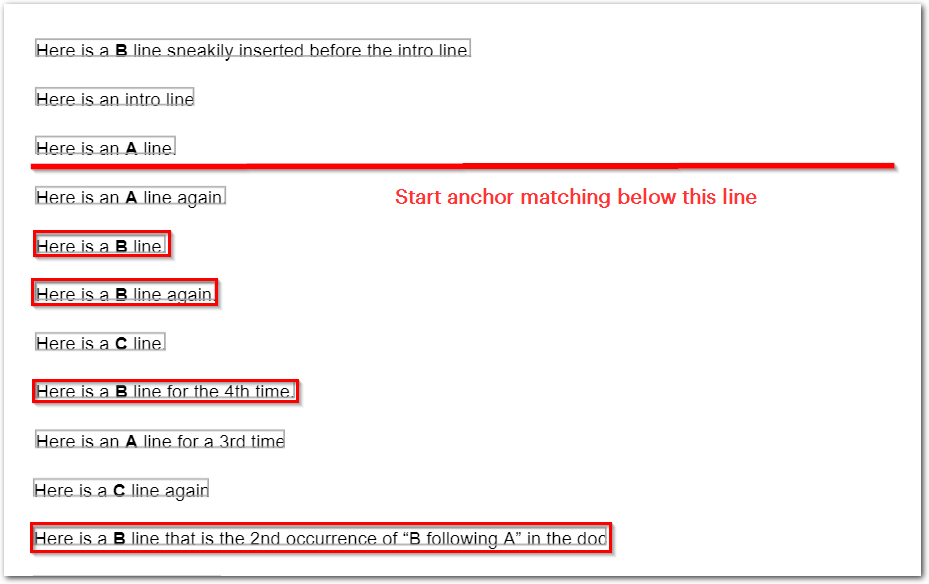Match arrays
Note: If you're familiar with Sensible, this detailed topic is for you. If you're new to Sensible, see match.
Sensible matches the last element in a Match array if:
- Each array element targets a separate successive line in the document.
- The matches specified in the array occur in the document in the same order as in the array. For more information about line ordering, see Lines.
This example creates an Anchor line using the last element in the array:
{
"fields": [
{
"id": "match_array",
"anchor": {
"start": "My section heading to start matching on",
"end": "My footer text to stop matching on",
"includeEnd": true,
"match":
[
{
"type": "includes",
"text": "finds anchor if you match this string in a line",
},
{
"type": "startsWith",
"text": "followed by the first occurrence of this string in another line",
},
{
"type": "regex",
"pattern": ".*create an Anchor line out of this last match",
},
]
},
"method": {
"id": "label",
"position": "below"
}
}
]
}Reverse match arrays
Use the Reverse parameter when a difficult-to-match target line precedes an easy-to-match line. You can match the easy line, then set "reverse:true" to search preceding lines until you match the difficult line.
Config
{
"fields": [
{
"id": "reverse_example",
"anchor": {
"match": [
{
"type": "startsWith",
"text": "section header"
},
{
"type": "startsWith",
"text": "an unusual line"
},
{
"type": "startsWith",
"text": "a common line",
"reverse": true
}
]
},
"method": {
"id": "label",
"position": "below",
"textAlignment": "hangingIndent"
}
}
]
}Example document
The following image shows the example document used with this example config:

| Example document | Download link |
|---|
Output
{
"reverse_example": {
"type": "string",
"value": "Target data"
}
}Notes
In a reverse match array, Sensible searches for anchor candidates in sequence, and rules out overlapping match arrays. The following image illustrates this behavior for the example config:

Nuances: Match arrays versus Anchor start
Match arrays have a different effect from a start-and-match combination. For example, at first glance, the following anchors may appear to be different syntaxes for finding the same matching text:
Anchor 1
"anchor": {
// match array
"match": [
{
"type": "startsWith",
"text": "here is an A line"
},
{
"type": "startsWith",
"text": "here is a B line"
}
]
},Versus:
Anchor 2
"anchor": {
// same matches, same sequence, but in Start and Match parameters
"start": {
"type": "startsWith",
"text": "here is an A line"
},
"match": {
"type": "startsWith",
"text": "here is a B line"
}
The difference between these two is:
- anchor 1 finds an instance of line B preceded by line A.
- anchor 2 searches after the first instance of line A for a line B, and discards anything earlier in the document.
To clarify the difference, consider a simple document with the following content:
EXAMPLE DOCUMENT
Here is a B line sneakily inserted before the intro line.
Here is an intro line
Here is an A line.
Here is an A line again.
Here is a B line.
Here is a B line again.
Here is a C line.
Here is a B line for the 4th time.
Here is an A line for the 3rd time.
Here is a C line again
Here is a B line that is the 2nd occurrence of “B following A” in the doc
Here is an ending line.For Anchor 1, Sensible anchors on the last Match array element if it's preceded by the other array elements in order. "match":all" finds two anchors. See the following image for an illustration:

-
For Anchor 2, Sensible searches after the first instance of
here is an A line, and discards anything earlier in the document."match":all"finds four anchors. Notice it doesn't anchor on the first line B (Here is a B line sneakily inserted before the intro line) because that instance precedes the start match. See the following image for an illustration:
Try out this example in the Sensible app using the following document and config:
| Example document | Download link |
|---|
This example uses the following config:
{
"fields": [
{
"id": "match_array",
"match": "all",
"anchor": {
"match": [
{
"type": "startsWith",
"text": "here is an A line"
},
{
"type": "startsWith",
"text": "here is a B line"
}
]
},
"method": {
"id": "passthrough"
}
},
{
"id": "start_and_match",
"match": "all",
"anchor": {
"start": {
"type": "startsWith",
"text": "here is an A line"
},
"match": {
"type": "startsWith",
"text": "here is a B line"
}
},
"method": {
"id": "passthrough"
}
}
]
}And the output of this example is:
{
"match_array": [
{
"type": "string",
"value": "Here is a B line."
},
{
"type": "string",
"value": "Here is a B line that is the 2nd occurrence of “B following A” in the doc"
}
],
"start_and_match": [
{
"type": "string",
"value": "Here is a B line."
},
{
"type": "string",
"value": "Here is a B line again."
},
{
"type": "string",
"value": "Here is a B line for the 4th time."
},
{
"type": "string",
"value": "Here is a B line that is the 2nd occurrence of “B following A” in the doc"
}
]
}Updated 15 days ago